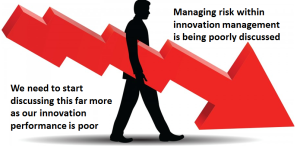![]() I believe we need a new way to manage risk within our innovation activities. It needs to be treated differently from the general ‘risk management’ criteria applied within our business organizations.
I believe we need a new way to manage risk within our innovation activities. It needs to be treated differently from the general ‘risk management’ criteria applied within our business organizations.
In a three-part series, part one outlined the implicit need to align innovation to the corporate strategy, and through this we can determine ‘acceptable risk’.
In part two I offered numerous reasons why we should recognize and treat innovation risk differently to allow it to perform closer to its promise of driving growth and achieving real advantage.
This post here is the third and last part, part three, where I lay out different mechanisms and framing of risk and innovation. These need to be evolved to fit your own risk appetite, not one size fits all. I hope it helps.
Risks are certainly shifting. In a recent piece of work by Deliottes called “Risk sensing:the (evolving) state of the art, the risks of most concern are changing each year. Interestingly, the pace of innovation stands among the top three risks in 2015 and tops along with regulatory risk, the list was foreseen in 2018. With technology disruption, business model disruption and growing competition, social and customer engagement challenge the ability to manage innovation is growing as a concern and in risk management.
We need to formulate a more robust risk innovation framework.
Risk management for innovation needs to evolve to keep pace with the changing demands and pace of change we are undergoing in business challenges. Risk is becoming an evolving capability.



